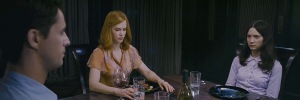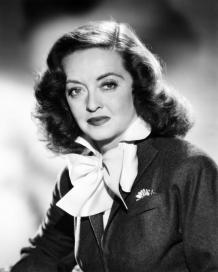Stoker is something of an enigma. Released in the relative doldrums of cinema’s late winter season, it is a combination coming-of-age story and psychological thriller that hearkens back to iconic instances of movie suspense and teenage gore. Acclaimed South Korean director Park Chan-wook, here working with his first English language film, seems hyperaware of his references to these genres’s conventions, prioritizing such appropriations alongside sumptuous imagery. Style soon overcomes substance and too often distracts or obscures the mysterious story Park eventually sets forth. Yet among these numerous, bizarre elements, something about Stoker seems to click.

Uncle Charlie (Goode), his sister-in-law Evelyn (Kidman), and niece India (Wasikowska) develop an intense, semi-incestuous triangle.
Mia Wasikowska stars as India Stoker, a brooding, introverted teenage girl, seemingly preserved in her innocence. But when her father dies on her eighteenth birthday, she is left with the threatening presence of her indulgent, competitive mother, Evelyn (Nicole Kidman), and her father’s estranged younger brother, Charlie (Matthew Goode). The two engage in a semi-incestuous relationship until Uncle Charlie’s sights turn to India, awakening a darkly sexual and disturbed side of her psyche. The household is thus divided into a sexually charged triangle of combatting intellectual control, dependent on discovering the murderous truth beneath Uncle Charlie’s suave, calculated facade.

Uncle Charlie shares understated confidence, a stoic smile, handiwork, and general appearance with Norman Bates (Anthony Perkins) of Psycho.
Initially, the characters and the dynamics of their relationships are negotiated through extensive use of certain cinematic tropes. India’s dark hair (parted down the middle) and clothing, black-and-white Sunday school shoes, and stoic face recall other innocent characters, such as Sissy Spacek’s Carrie (Carrie, 1976), who keep to themselves to silence their destructive potential. More noticeably, Uncle Charlie borrows heavily from a number of cinema’s most infamous killers, including the demeanor of Norman Bates (Psycho, 1960), the name of Joseph Cotten’s character in Hitchcock’s Shadow of a Doubt (1943), and the impending whistle of the child murderer in Fritz Lang’s M (1931). The extent to which and lack of subtlety in how the script utilizes such appropriations, however, greatly harms the film’s story. By highlighting the excess and artificiality of particular generic expectations and assumptions, the film often reads as false or unintended pastiche.
Depending on the opinion of the viewer, this lack of organic storytelling apparent from Stoker‘s beginning is either frustrated or appeased by the film’s vividly defined style. The sharpness of the film’s look and design is certainly inarguable. The lavish sets, period-transcending costumes, and diverse cinematography – from stark to clouded frames, tilt-shift to deep focus space – present contemplative visuals that are, in the very least, engrossing. A sense of assertion in the film’s priority of style over substance becomes clear, until the multitude of clever graphic matches and seamless edits, too, grow tiresome.

India is initially nervous in her piano playing with Uncle Charlie, but soon submits to mounting sexual tension.
Finally, Stoker does pick up from its determined but slow pace, which makes its beginning riveting only through anticipation of anything significant eventually happening. Halfway through the film, this moment arrives as India sits at her grim piano, reprising a tune played throughout the film, but now envisioning her uncle joining her on the lower notes. The passion of their synchronistical playing and of the music inevitably builds into a devouring embrace, as the perceived sexual tension materializes in her intensely erotic fantasy. This, the first important admittance of India’s latent desires, catalyzes the ensuing unleashing of her sexuality, which becomes more recognizably related to fatality and violence as she delves deeper into Uncle Charlie’s hidden past.

India’s relationship to her surroundings is quickly disturbed, symbolized by her change in hunting habits.
What follows is a blur of reveal and unraveling acts that I do not wish to spoil. So, I will suffice in commenting on the mastery of Park’s overall subversion, the focus of the film’s form and story flowing from deliberate meditation (India’s keen awareness of her surroundings elaborated upon in her opening narration) to the preying power of observance (discovered in India’s interest in hunting, through which she warns “you do something bad to prevent yourself from doing something worse”) across the film’s trajectory. The grace and gentle beauty with which India originally senses the world translates, by the film’s conclusion, into a realization of animosity and mortality inherent to nature. And without the hunting trips her father devised to condition her darker side, left only to the devices of her embittered mother and scheming uncle, India is abandoned of nurture and lost within a cycle of violence propagated by Uncle Charlie. She has effectively, by film’s end, been caught between these two facets of her sanity.
Despite the disappointingly overt cliches used to ground the film’s story, Park turns Stoker into a decently satisfying commentary on, or perhaps questioning of, the contrasting dangers society, upbringing, and lack of civilization each pose to humankind through the experiences of one girl. If nothing more, Park seeks, like India plunging pruning shears into the face of a random police officer, “just to get your attention.”








